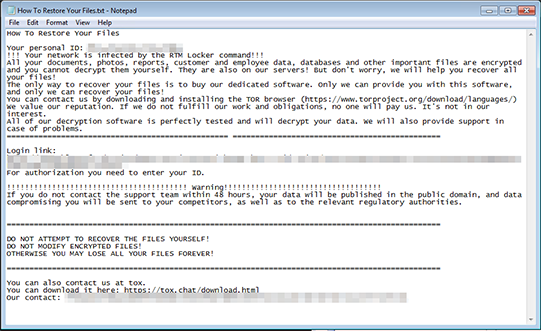Ransom.Win32.RTMCOMMAND.THKBFBB
HEUR:Trojan-Ransom.Win32.Encoder.gen(KASPERSKY)
Windows


Threat Type: Ransomware
Destructiveness: No
Encrypted: No
In the wild: Yes
OVERVIEW
Downloaded from the Internet, Dropped by other malware
This Ransomware arrives on a system as a file dropped by other malware or as a file downloaded unknowingly by users when visiting malicious sites.
It drops files as ransom note.
TECHNICAL DETAILS
281,600 bytes
EXE
No
Encrypts files, Displays message/message boxes
Arrival Details
This Ransomware arrives on a system as a file dropped by other malware or as a file downloaded unknowingly by users when visiting malicious sites.
Installation
This Ransomware adds the following processes:
- %System%\cmd.exe" /c PING -n 5 127.0.0.1 > NUL && del "{Malware Full Path}" → deletes itself
(Note: %System% is the Windows system folder, where it usually is C:\Windows\System32 on all Windows operating system versions.)
Other System Modifications
This Ransomware changes the desktop wallpaper by modifying the following registry entries:
HKEY_CURRENT_USER\Control Panel\Desktop
Wallpaper = "%User Temp%"\img{3 Random Characters}.tmp
Process Termination
This Ransomware terminates the following processes if found running in the affected system's memory:
- sql.exe
- oracle.exe
- ocssd.exe
- dbsnmp.exe
- synctime.exe
- agntsvc.exe
- isqlplussvc.exe
- xfssvccon.exe
- mydesktopservice.exe
- ocautoupds.exe
- encsvc.exe
- firefox.exe
- tbirdconfig.exe
- mydesktopqos.exe
- ocomm.exe
- dbeng50.exe
- sqbcoreservice.exe
- excel.exe
- infopath.exe
- msaccess.exe
- mspub.exe
- onenote.exe
- outlook.exe
- powerpnt.exe
- steam.exe
- thebat.exe
- thunderbird.exe
- visio.exe
- winword.exe
- wordpad.exe
- notepad.exe
Information Theft
This Ransomware accepts the following parameters:
- -debug - Display debug info
Other Details
This Ransomware does the following:
- It uses WQL to delete shadow copies.
- It encrypts network drives.
- It empties recycle bin
- If not executed with admins rights, it will relaunch itself as admin using this command:
- %System%\cmd.exe" /c ECHO "You must restart the program to resolve a critical error" && start "" {Malware Full Path}
(Note: %System% is the Windows system folder, where it usually is C:\Windows\System32 on all Windows operating system versions.)
Ransomware Routine
This Ransomware avoids encrypting files found in the following folders:
- windows
- appdata
- application data
- boot
- mozilla
- program files
- program files (x86)
- programdata
- system volume information
- tor browser
- windows.old
- intel
- msocache
- perflogs
- x64dbg
- public
- all users
- default
It appends the following extension to the file name of the encrypted files:
- .{64 Random Characters}
It drops the following file(s) as ransom note:
- "%User Temp%"\img{3 Random Characters}.tmp

- {Encrypted directory}\How To Restore Your Files.txt

SOLUTION
9.800
17.898.04
26 Oct 2022
17.899.00
27 Oct 2022
Step 1
Trend Micro Predictive Machine Learning detects and blocks malware at the first sign of its existence, before it executes on your system. When enabled, your Trend Micro product detects this malware under the following machine learning name:
- Troj.Win32.TRX.XXPE50FFF061
Step 2
Before doing any scans, Windows 7, Windows 8, Windows 8.1, and Windows 10 users must disable System Restore to allow full scanning of their computers.
Step 3
Note that not all files, folders, and registry keys and entries are installed on your computer during this malware's/spyware's/grayware's execution. This may be due to incomplete installation or other operating system conditions. If you do not find the same files/folders/registry information, please proceed to the next step.
Step 4
Search and delete these files
- %User Temp%\img{3 Random Characters.tmp}
- {Encrypted directory}\How To Restore Your Files.txt
Step 5
Scan your computer with your Trend Micro product to delete files detected as Ransom.Win32.RTMCOMMAND.THKBFBB. If the detected files have already been cleaned, deleted, or quarantined by your Trend Micro product, no further step is required. You may opt to simply delete the quarantined files. Please check the following Trend Micro Support pages for more information:
Step 6
Restore encrypted files from backup.
Step 7
Reset your Desktop properties
Did this description help? Tell us how we did.

